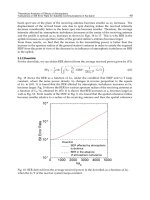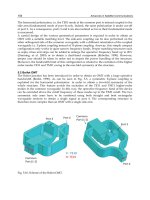Resource Management in Satellite Networks part 35 potx
Bạn đang xem bản rút gọn của tài liệu. Xem và tải ngay bản đầy đủ của tài liệu tại đây (131.02 KB, 8 trang )
Chapter 10: CROSS-LAYER METHODS AND STANDARDIZATION 329
techniques, especially in the return link for terminals with small antennas.
The adoption of spectrum spreading is a possible solution to reduce the
EIRP, while preserving the required SNR, at the expenses of reduced
spectral efficiency. In the forward link, the introduction of spreading
requires the design of a new DVB-S2 receiver. In the return link, each
terminal could in principle implement direct spreading within the assigned
time and frequency slot (MF-TDMA approach).
• Fading countermeasures: the more challenging propagation conditions of
the non-LoS scenario can be mitigated by adopting advanced techniques
such as diversity and higher layer FEC schemes. Moreover, new synchro-
nization acquisition and maintenance procedures need to be employed to
cope better with frequent fades.
• Resource management techniques: efficient RRM schemes need to be
adopted to account for mobility, such as: impact of spreading on the
MF-TDMA allocation process (DVB-RCS); support of handover requests
with suitable protocols; interworking with terrestrial networks in shadowed
areas (e.g., tunnels, cities, etc.) where gap fillers can be used; adaptive
schedulin techniques for the forward link that are aware of the physical
layer behavior.
All these innovative aspects require a cross-layer system design aiming at
optimizing the choices made at different layers. The DVB-TM is now working
to specify the modifications that are needed for the mobile extension of the
DVB-S2 standard [23]. The SatNEx II project [24] is actively involved in this
standardization process.
DVB-H
The broadcast of digital television signals was originally targeted to fixed
reception, although mobile reception is also feasible with current digital
television standards (DVB-T, DVB-S2). The Commercial Module of DVB
decided to launch commercial requirements for the production of ad hoc
specifications able to provide broadcasting to one specific niche of the mobile
receivers: handheld terminals. This is the aim of the DVB-Handheld (DVB-H)
standard.
Conditional access is important in all broadcast radio/satellite networks
to prevent unauthorized access to the broadcast content by eaves-dropping.
In DVB-H, an IP-based Conditional Access System (IP-CAS) can provide
link-layer encryption (scrambling) for DVB-H services. CAS messages are
delivered over IP and may take advantage of time-slicing to save power at
a receiver. The DVB common scrambling algorithm on Transport Stream
packets is also employed (DVB-CAS): it uses entitlement control messages to
send keys to receivers and entitlement management mode messages to deliver
management messages.
330 G. Fairhurst, M. A. V´azquez Castro, G. Giambene
10.6.5 International Telecommunication Union
ITU is an international organization of the United Nations where governments
and industries coordinate global telecom networks and services. ITU is divided
in three sectors: ITU-T that aims at the definition of high-quality standards
covering all fields of telecommunications; ITU-R that plays a fundamental role
in the management of the radio-frequency spectrum, physical layer issues, and
satellite orbits; and ITU-D, dealing with Telecommunications Developments.
ITU-R is charged with determining the technical characteristics and
operational procedures for a huge and growing range of wireless services.
This Sector also plays a vital role in the management of the radio-frequency
spectrum, a finite natural resource that is increasingly in demand due to the
rapid development of new radio-based services and the enormous popularity
of mobile communication technologies.
In its role as global spectrum coordinator, ITU-R develops and adopts
the Radio Regulations, a voluminous set of rules that serve as a binding
international treaty governing the use of the radio spectrum for different
services around the world. ITU-R also acts, through its Bureau, as a central
registrar of international frequency use, recording and maintaining the Master
International Frequency Register, which currently includes around 1,265,000
terrestrial frequency assignments, 325,000 assignments servicing 1,400 satellite
networks, and another 4,265 assignments related to satellite Earth stations.
Moreover, ITU-R is responsible for coordinating efforts to ensure that commu-
nication, broadcasting and meteorological satellites in the world’s increasingly
crowded skies can co-exist without causing harmful interference each other.
The Union facilitates agreements between both operators and governments,
and provides practical tools and services to help frequency spectrum man-
agers.
The portion of the radio-frequency spectrum suitable for communications
is divided into ‘blocks’, the size of them varying according to individual
services and their requirements. These blocks are called ‘frequency bands’
and are allocated to services on an exclusive or shared basis. The full list of
services and frequency bands allocated in different regions forms the Table of
Frequency Allocations, which is a part of the radio regulations.
10.7 Conclusions
A range of cross-layer optimization techniques have been proposed and
evaluated in this book for three different scenarios (i.e., DVB-S/DVB-RCS
via GEO bent-pipe satellite, S-UMTS via GEO bent-pipe satellite, and LEO
constellation with regenerating satellites). The most significant techniques
have been summarized in this Chapter to provide final guidelines for both
standardization efforts and further research directions.
Cross-layer methods have been categorized, considering: (i) either explicit
Chapter 10: CROSS-LAYER METHODS AND STANDARDIZATION 331
signaling or an implicit scheme with a joint optimization of different protocol
layers; (ii) the definition at higher layers of requirements to be used for ap-
propriate settings at lower layers or, vice-versa, the lower layers progressively
determining the requirements at higher layers. As for explicit cross-layer, we
have described different mechanisms for the exchange of internal protocol state
information between non-adjacent protocol layers, thus violating the classical
ISO/OSI layered philosophy.
We have proved that the cross-layer techniques can improve the overall
end-to-end quality of service, while optimizing the efficiency in utilizing the
scarce satellite radio resources. However, standardization fora have not yet
significantly addressed cross-layer issues. To this aim, there is a need for a
new framework, as well as the strong cooperation of different standardization
bodies. One of the aims of this book has been to provide some useful insights
that may promote new standardization activities on cross-layer air interface
design for satellite communication networks.
References
[1] J.H.Saltzer,D.P.Reed,D.D.Clark,“End-to-EndArgumentsinSystem
Design”, ACM Transactions in Computers Systems, Vol. 2, No. 4, pp. 277-288,
November 1984.
[2] P. Karn, C. Bormann, G. Fairhurst, D. Grossman, R. Ludwig, J. Mahdavi, G.
Montenegro, J. Touch, L. Wood, “Advice for Internet Subnetwork Designers”,
BCP 89, IETF RFC 3819, July 2004.
[3] S. Floyd, V. Jacobson, “Random Early Detection Gateways for Congestion
Avoidance”, IEEE/ACM Transactions on Networking, Vol. 1, No. 4, pp.
397-413, August 1993.
[4] M. van der Schaar, S. Shankar, “Cross-Layer Wireless Multimedia Transmission:
Challenges, Principles, and New Paradigms”, IEEE Wireless Communications
Magazine, Vol. 12, No. 4, pp. 50-58, August 2005.
[5] Q. Wang, M. A. Abu-Rgheff, “Cross-Layer Signalling for Next-Generation
Wireless Systems”, in Proc. of IEEE Wireless Communications and Networking
Conference 2003 (IEEE WCNC 2003), New Orleans, USA, pp. 1084-1089,
March 2003.
[6] The Internet Engineering Task Force (IETF); Web page with URL:
.
[7] European Telecommunications Standards Institute (ETSI); Web page with
URL: .
[8] International Telecommunication Union; Web page with ULR:
/>[9] MoSSA, Advanced Satellite Mobile Systems-Task Force Specific
Support Action, Project IST-507557, Deliverable “Survey on
Standardization and Regulatory Activities”; Web site with URL:
/>[10] ETSI TC-SES working group; Web page with URL: />[11] ETSI, “Satellite Earth Stations and Systems (SES); Satellite Component of
UMTS/IMT2000; G-family; Part 1: Physical channels and mapping of transport
channels into physical channels (S-UMTS-A 25.211)”, TS 101 851-1.
[12] ETSI, “Satellite Earth Stations and Systems (SES); Satellite Component of
UMTS/IMT2000; G-family; Part 2: Multiplexing and channel coding (S-UMTS-
A 25.212)”, TS 101 851-2.
334 G. Fairhurst, M. A. V´azquez Castro, G. Giambene
[13] ETSI, “Satellite Earth Stations and Systems (SES); Satellite Component of
UMTS/IMT2000; G-family; Part 3: Spreading and modulation (S-UMTS-A
25.213)”, TS 101 851-3.
[14] ETSI, “Satellite Earth Stations and Systems (SES); Satellite Component of
UMTS/IMT2000; G-family; Part 4: Physical layer procedures (S-UMTS-A
25.214)”, TS 101 851-4.
[15] ETSI, “Satellite Earth Stations and Systems (SES); Satellite Component of
UMTS/IMT2000; G-family; Part 5: UE Radio Transmission and Reception (S-
UMTS-A 25.101)”, TS 101 851-5.
[16] ETSI, “Satellite Earth Stations and Systems (SES); Satellite Component of
UMTS/IMT2000; G-family; Part 6: Space Segment Radio Transmission and
Reception (S-UMTS-A 25.104)”, TS 101 851-6.
[17] IST-MAESTRO project, “Mobile Applications & sErvices based on Satellite &
Terrestrial inteRwOrking”; Web site with URL: ,
2006.
[18] ETSI, “Evaluation of the OFDM as a Satellite Radio Interface Satellite Earth
Stations and Systems (SES); Satellite Component of UMTS/IMT-2000”, TR
102 433, 2006.
[19] Digital Video Broadcasting (DVB) Project; Web page with URL:
.
[20] ETSI, “Digital Video Broadcasting (DVB); Interaction channel for Satellite
Distribution Systems”, EN 301 790.
[21] SatLabs official Web site with URL: />[22] ETSI, “Digital Video Broadcasting (DVB); Second Generation Framing
Structure, Channel Coding and Modulation Systems for Broadcasting,
Interactive Services, News Gathering and other Broadband Satellite
Applications”, EN 302 307.
[23] S. Scalise, G. E. Corazza, C. P´arraga Niebla, P. Chan, G. Giambene, F. Hu, A.
Vanelli-Coralli, M. A. V´azquez Castro, “Towards the Revision of DVB-S2/RCS
Standard for the Full Support of Mobility”, SSC Newsletter, Vol. 17, No. 2,
November 2006.
[24] SatNEx II Web site with URL: .
Index
A
Access protocol, 120, 132
Adaptive algorithms, 209, 295
Adaptive coding and modulation, 16,
24, 106, 139, 208, 316
Asynchronous transfer mode, 109
B
Broadband satellite multimedia, 28, 31,
69, 98, 256
Broadcast and multicast services, 5, 80,
152, 160
C
CAC, 45, 51, 100, 110, 177, 179, 184,
189, 199, 257
Complete partitioning, 52, 179
Complete sharing, 52, 179
Call handover, 53, 189, 195, 214, 233
Inter-satellite handover, 54, 190, 194,
214
Intra-satellite handover, 54, 190, 191,
214
CDMA, 14
Channel quality indicator, 138
Channel utilization, 162, 305
Combined free/demand assignment
multiple access, 48, 101, 256
Commercial solutions, 82, 89
Communications architecture, 314, 320
Cross-layer signaling, 320
Congestion control, 164, 186
Control-theoretic approach, 213
Cross-layer approach, 34, 156, 164, 256,
314
Bottom-up approach, 316
Hybrid approach, 317
Top-down approach, 316
Cross-layer design, 35, 36, 45, 96, 105,
214, 221, 256, 270, 313, 314
Explicit cross-layer, 35, 36, 133, 145,
156, 164, 300, 315
Implicit cross-layer, 35, 36, 45, 95,
217, 270, 290, 315, 317
D
Delayed real-time services, 83
Demand assignment multiple access, 18,
290, 298, 300
Access delay, 290, 298
Rate-based dynamic capacity, 20,
211, 221, 249, 299
Volume-based dynamic capacity, 20,
211, 221, 249, 299, 303
DiffServ, 36, 77, 107, 183, 246
DVB-S, 16, 80, 105, 187, 326
DVB-RCS, 17, 81, 186, 211, 249, 289,
298, 323, 327
Adaptive coding, 218
Implementation issues, 218, 228
MF-TDMA scheme, 15, 17, 184,
211, 251, 302, 327
E
ETSI TC SES S-UMTS working group,
15, 121, 325
336 Index
Explicit congestion notification, 107
F
FDMA, 13
G
GEO satellite systems, 4, 10, 68, 71,
125, 131, 141, 184, 209, 265, 290
H
Handover algorithms, 51
Handover queuing, 53
Predictive resource reservation, 54
HSDPA, 16, 108, 138, 139, 141, 144, 148
Hybrid satellite networks, 265
Erasure codes, 265
QoS, 266
WiFi networks, 267
I
Infinitesimal perturbation analysis, 99,
216, 257
IntServ, 36, 77, 107, 183, 244
L
LEO satellite systems, 4, 10, 54, 68, 71,
132, 141, 189, 192, 195
M
MAC, 18, 97, 98, 105, 110, 119, 139,
248, 256, 298
MEO satellite systems, 4, 10, 48, 71,
141
Modeling and simulation, 54
N
NCC, 17, 178, 208, 298, 327
Network layer, 243
Node-B, 139
O
OSI model, 34, 102
P
Packet scheduler, 134, 137, 140, 152,
155, 164
Performance enhancing proxies, 29, 99,
293
Power allocation and control, 50
Closed loop, 50
Feedback loop, 50
Open loop, 50
Proactive algorithms, 210
Q
QoS classes, 156, 165
QoS for multimedia services, 68
Background services, 76
Conversational services, 70
Interactive services, 73
Performance requirements, 70, 73, 74,
76
QoS based IP models, 76
Streaming services, 74
QoS mapping, 98, 256, 260
R
Radio resource management, 43, 54, 96,
101, 119, 177, 289, 303, 318
Cross-layer approach, 45, 60, 96, 99,
101, 104, 214, 295, 303, 305
Joint optimization, 95, 97–100
MAC-centric approach, 105
Dynamic allocation, 20, 47, 49, 55,
99, 101, 110, 191, 198, 208, 211,
213, 214, 218, 233, 248, 251, 256,
299
Fairness, 44, 217, 232
Reactive algorithms, 210
Receding horizon controller, 214
Resource allocation, 23, 46, 99, 121,
138, 158, 179, 184, 208, 225, 249,
299
Frequency allocation, 46
Space allocation, 46
Time allocation, 46
S
S-UMTS, 15, 58, 108, 121, 131, 152, 325
Satellite constellations/orbits, 4, 10, 275
Satellite digital multimedia
broadcasting, 325
Satellite IP networks, 31, 69, 76, 109,
248
Index 337
IP QoS, 76, 109, 183, 244, 248
Proportional DiffServ, 249
Scheduling scheme, 134
Channel-aware scheduling, 135
Exponential Rule scheduler, 138
Maximum C/I scheduler, 138
Proportional Fair scheduler, 138, 147
Service level agreement, 96, 222, 246
SI-SAP, 31, 98, 256
Smith predictor controller, 214
Standardization, 322
Static algorithms, 209
T
TCP over satellite, 290
Cross-layer interactions, 294, 298
MODCOD optimization, 294
TDMA, 13
Transport layer, 99, 289
Congestion control, 291
TCP, 99, 273, 290, 294, 298
UDP, 273, 290, 305
U
UMTS, 15, 58, 121
V
VLANs for LEO constellations, 270
Voice over IP, 50, 70, 262
W
W-CDMA, 16, 46, 137









